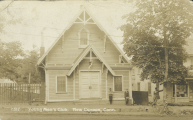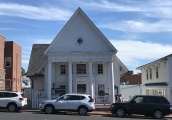62 Main St.
Most may be familiar with this building today, but it is almost unrecognizable in this c 1910 photo.
This the first Baptist Church in New Canaan, which now stands at 62 Main Street.
This church was built in 1872 by the local New Canaan Baptist congregation. Like every religious congregation in town, the local Baptists had grown tired of spending their Sundays traveling from New Canaan to either Stamford or Norwalk for their services. The project was spearheaded by Watts Comstock. Comstock’s involvement would not have been a surprise to residents at the time as his parents, Enoch and Anna, were the first Baptists in New Canaan. The first service in the church was held on February 6, 1873, and the parishioners included the Tuttle, Weed, Selleck, and Benedict families. The baptism immersion pool was located under the pulpit, but most converts preferred to head down the hill to be baptized in Mill Pond. However by the turn of the century, attendance started to wane, and there were no longer the funds to keep the building.
In 1908, the building was sold to Dr. James W. McLane, who immediately started to expand the building. The back of the church was expanded. He did bump out the front of the building by a few feet so the exterior walls were flush with the front entrance. Once work was done, Dr. McLane, along with a group of summer residents, financed the “Young Men’s Club” or the “Boys Club.” With space for a reading/club room along with a gymnasium, it was essentially a precursor to the YMCA. However, despite the improvements, interest in the club was so low by 1913 that the building was given to the library for its building fund. The library stayed in its Elm Street location and 62 Main was rented out to future Selectman George T. Smith and his business partner Segbert S. Brinckeroff. The pair converted the building into the Suburban Theater, a movie theater and playhouse. Tickets were a dime and show times were often listed on the front page of the Advertiser. Acts such as Harry L. Bill, a blind banjo player, drew standing room only crowds. Other acts were not so lucky. One act from Springdale was booed off stage after only five minutes and the Advertiser reported they “beat it before the grocer could fetch some eggs to throw at them.” When the Suburban Theater folded it was replaced by the Pleasant Hour Theater, which seems to have almost immediately closed. The property was then sold to Francis E. Green, who started his real estate firm in the building. Green later became a major developer of much of the downtown area of New Canaan. In 1917, Green sold the building to the local chapter of the Masonic Order, Harmony Lodge No. 67.
62 Main Street was Harmony Lodge’s first home of its own. The chapter had been founded in 1825, but the members had rented meeting space in the Town House, now the main building of the New Canaan Museum & Historical Society, for $20 a month. The Main Street building was once again remodeled, giving it its current facade with funds provided by Lucius Monroe Jr. in honor of his father Lucius Sr., who had been a longtime member of the lodge. The pair were the owners of the Monroe Drugstore and later the Cody Drugstore, the interior of which is now one of the most impressive historic museums at the New Canaan Museum & Historical Society. The Masons held their meetings here until 1955, when the property was a subject of one of the more confusing land transfers in New Canaan history. The Masonic lodge, 62 Main Street, was transferred to the VFW, who in turn gave their property on South Ave to the Methodist Church. The Methodists then gave its old church on the corner of Main and Church Street to the Masons. This was all done without a single dollar changing hands. The VFW then held their meetings in the building for twenty one years.
In 1974 the building was bought by another fraternal organization – the Knights of Columbus. The street level room was converted into a space that could serve as either an auditorium or chapel, while the lower room was made into a full bar. The bar was accessed by heading down the alley and hitting a buzzer by a locked door. Though technically only accessible to members of the Knights of Columbus, the door would always be opened by a Knight who would sign you in as a guest. During these dozen years, the building was the location of wedding receptions, voting stations, and possibly the first Heimlich maneuver ever performed in town.
The building was once again sold in 1987 to architect Jim Schetino, who kept his office above the ground floor. After another round of remodeling the upper and lower spaces were converted into restaurants. The ground floor, now occupied by Chief Prasad, was first occupied by L’Abbe. The lower level, the long-time home of Vicolo and future site of Best Pizza Shop, was first Lobo’s.
“New Canaan Now & Then” is presented in partnership with the New Canaan Museum & Historical Society.


